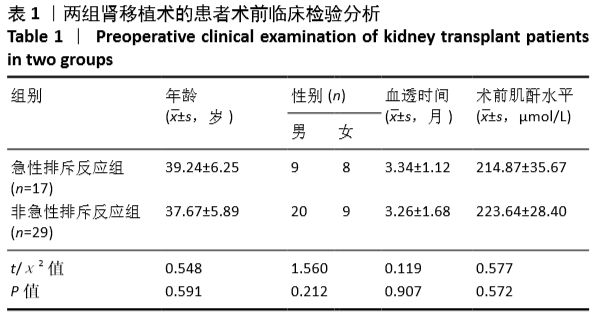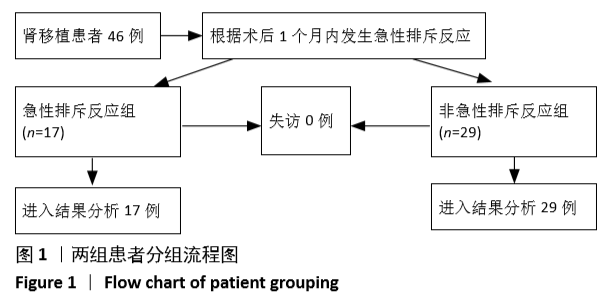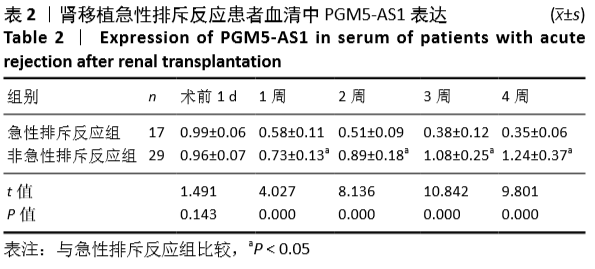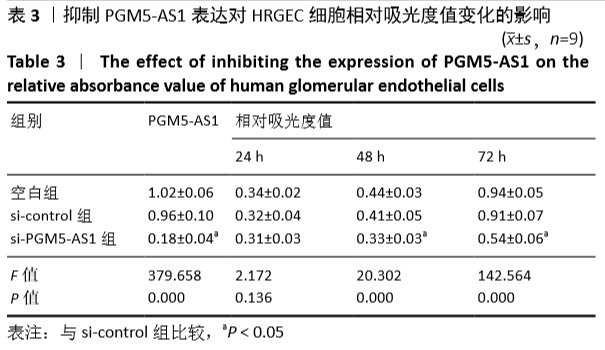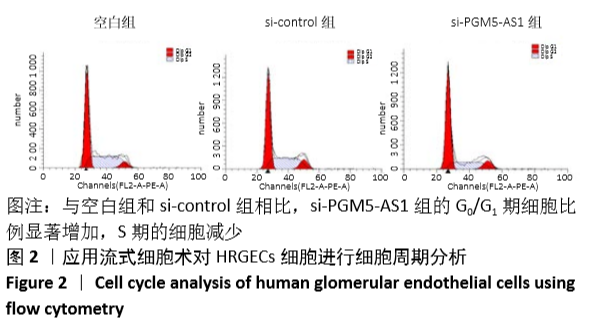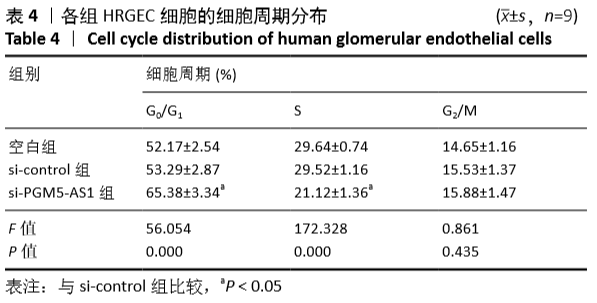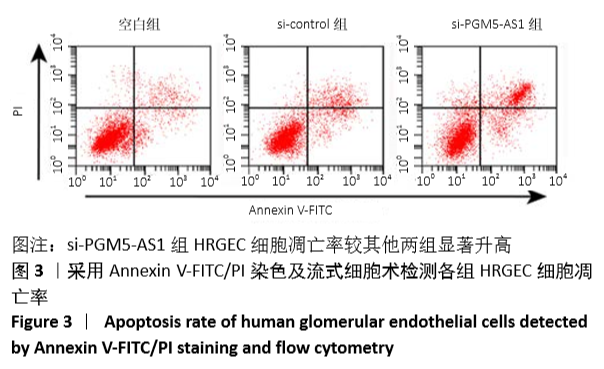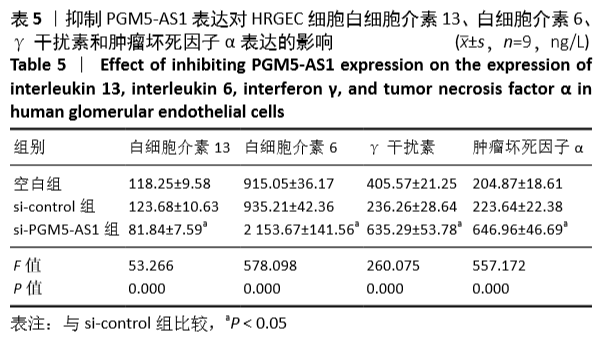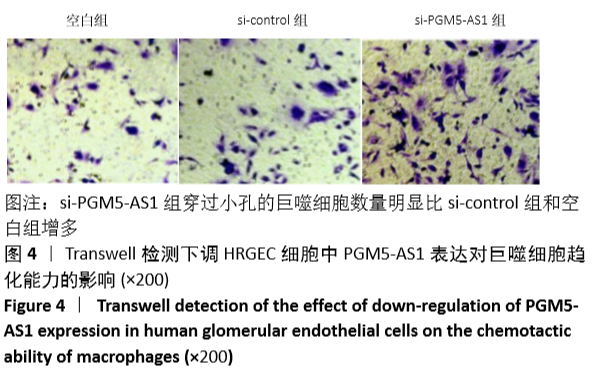中国组织工程研究 ›› 2021, Vol. 25 ›› Issue (5): 741-745.doi: 10.3969/j.issn.2095-4344.3009
• 组织构建临床实践 clinical practice in tissue construction • 上一篇 下一篇
肾移植患者血清中长链非编码RNA PGM5-AS1表达及调控人肾小球内皮细胞的作用
蒋 欣,乔良伟,孙 东,李 明,房 军,曲青山
- 郑州人民医院器官移植科,河南省郑州市 450003
Expression of long chain non-coding RNA PGM5-AS1 in serum of renal transplant patients and its regulation of human glomerular endothelial cells
Jiang Xin, Qiao Liangwei, Sun Dong, Li Ming, Fang Jun, Qu Qingshan
- Department of Organ Transplantation, Zhengzhou People’s Hospital, Zhengzhou 450003, Henan Province, China
摘要:

文题释义:
巨噬细胞趋化性:巨噬细胞是一种来源于骨髓中的单核细胞,由前体细胞分化而来。巨噬细胞参与调解血细胞发育、胚胎期器官发育、血管生成、细胞凋亡和免疫排斥等;巨噬细胞沿着定向趋化因子浓度增加的信号向趋化因子源处的迁徙。
急性排斥反应:是由于受体识别供体抗原引起,主要是T淋巴细胞介导的免疫反应,效应细胞多为细胞毒性T细胞和记忆性T细胞,它们可能通过直接提呈方式被激活。急性排斥反应属于迟发性超敏反应,分为细胞性排斥反应和血管性排斥反应;应用抗排斥治疗多可逆转。
背景:lnc RNA PGM5-AS1在肾移植急性免疫排斥患者外周血清中表达降低,其表达对肾小球内皮细胞存活和巨噬细胞趋化性的影响还有待研究。
目的:探究lnc RNA PGM5-AS1在肾移植急性排斥反应患者和非急性排斥反应患者血清中的表达及其对肾小球内皮细胞(HRGEC)增殖、细胞周期、细胞凋亡及巨噬细胞趋化性的影响。
方法:①肾移植患者46例,根据术后1个月内发生急性排斥反应与否分为急性排斥反应组(17例)和非急性排斥反应组(29例),术前1 d及术后第1,2,3,4周各抽取外周血,qRT-PCR检测患者血清中PGM5-AS1表达;②将si-control和沉默PGM5-AS1(si-PGM5-AS1)转染至人肾小球内皮细胞(HRGEC细胞),以空白组为对照;qPCR检测转染后细胞中PGM5-AS1表达;MTT检测细胞增殖,流式细胞术检测细胞凋亡和细胞周期,ELISA检测细胞炎症因子分泌,Transwell检测巨噬细胞趋化性。研究方案经郑州人民医院伦理学委员会批准,所有患者签署知情同意书。
结果与结论:①与非急性排斥反应患者相比,肾移植急性排斥反应患者移植后1,2,3,4周血清中PGM5-AS1表达降低(P < 0.05);②沉默PGM5-AS1后HRGEC细胞中PGM5-AS1表达低于抑制si-control组和空白组(F=379.658,P < 0.05);③MTT结果显示,沉默PGM5-AS1可显著抑制HRGEC细胞增殖(P < 0.05);④流式细胞术检测显示,沉默PGM5-AS1诱导HRGEC细胞阻滞在G0/G1期和增加细胞凋亡(P < 0.05);⑤ELISA结果显示,沉默PGM5-AS1抑制白细胞介素13表达,增加白细胞介素6、γ干扰素和肿瘤坏死因子α表达(P < 0.05);⑥Transwell检测显示,沉默PGM5-AS1的HRGEC细胞增加巨噬细胞的趋化性(P < 0.05);⑦结果说明,PGM5-AS1在肾移植急性排斥反应患者血清中低表达,抑制PGM5-AS1能够促进HRGEC细胞损伤,可作为早期急性排斥反应的外周血诊断标志物,并可能成为治疗急性排斥反应的分子靶点。
https://orcid.org/0000-0002-7455-3690 (蒋欣)
中国组织工程研究杂志出版内容重点:组织构建;骨细胞;软骨细胞;细胞培养;成纤维细胞;血管内皮细胞;骨质疏松;组织工程
中图分类号:
